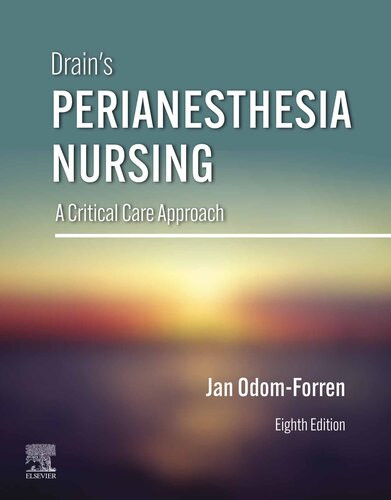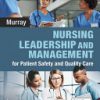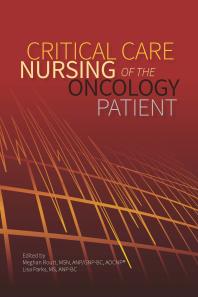Drain Peri Anesthesia Nursing A Critical Care Approach Eighth Edition by Jan Odom Forren 0323832687 9780323832687
$50.00 Original price was: $50.00.$25.00Current price is: $25.00.
Drain Peri Anesthesia Nursing A Critical Care Approach Eighth Edition by Jan Odom Forren – Ebook PDF Instant Download/Delivery: 0323832687, 9780323832687
Full download Drain Peri Anesthesia Nursing A Critical Care Approach Eighth Edition after payment

Product details:
ISBN 10: 0323832687
ISBN 13: 9780323832687
Author: Jan Odom-Forren
Trusted for more than 30 years, Drain’s PeriAnesthesia Nursing: A Critical Care Approach, 8th Edition provides comprehensive clinical content tailored specifically for perianesthesia nurses. An easy-to-use format with five distinct sections — covering the PACU, anatomy and physiology, pharmacology, nursing care, and special considerations — means you get the equivalent of five books in one. Nursing and pharmacologic interventions are integrated with in-depth coverage of pathophysiology, and updated content includes the latest standards and current issues affecting perianesthesia nursing practice. Focusing on research, documentation, and psychosocial considerations, this is the one book that can take you all the way from being a novice nurse in the PACU to preparing for CPAN® or CAPA® certification!
- Five separate sections provide comprehensive coverage, including the PACU, anatomy and physiology, pharmacology, nursing care, and special considerations.
- Coverage of current policies and issues affecting perianesthesia nursing practice includes patient safety, infection control, managed care implications, pain management, and bioterrorism.
- Comprehensive information on the various types of anesthetic agents familiarizes you with what will be used in the PACU.
- Special Considerations section details the care of patients with conditions such as malignant hyperthermia, substance abuse, sickle cell anemia, and cardiac arrest.
- UPDATED! Revised content throughout provides the most up-to-date information for effective perianesthesia nursing practice.
- NEW! Full-color layout makes content more visually appealing and highlights important information.
- NEW! Information on SARS/COVID-19 is now included in the Pathogens chapter.
- NEW! Chapter on International Care of the Perianesthesia Patient offers complete coverage on this key topic.
- UPDATED! Coverage of pain management for the perianesthesia patient features the latest guidelines.
- UPDATED! Patient with Chronic Disorders chapter provides current information on caring for these patients.
- UPDATED! Evidence-Based Research boxes provide the latest standards of care.
Drain Peri Anesthesia Nursing A Critical Care Approach Eighth Table of contents:
Section I: The Postanesthesia Care Unit
1: Space Planning and Basic Equipment Systems
Abstract
Space
Standard equipment
Summary
References
2: Perianesthesia Nursing as a Specialty
Abstract
References
Roles of perianesthesia nurses through the continuum of care
Nontraditional perianesthesia settings
Areas for growth within perianesthesia nursing
Summary
References
3: Management and Policies
Abstract
Purpose of the pacu
Organizational structure
Collaborative management
Role delineation
Talent recruitment, retention, and review considerations
Staffing
Summary
References
4: Crisis Resource Management in the PACU
Abstract
Introduction
The nature of human error
A systems approach to understanding error
Crisis management principles
Simulation and CRM training
Summary
References
5: Infection Prevention and Control in the PACU
Abstract
Managing the environment and equipment
General infection control practices
Management of the infected or contagious patient
Occupational health
Summary
References
6: The Changing Health Care System and Its Implications for the PACU
Abstract
Health care financing
The uninsured population
Health care workforce
Major medical services
Governments’ role in health care
2010 Health care reform
Implications for the PACU
Summary
References
7: Patient Safety and Legal Issues in the PACU
Abstract
Ethical values
Conscientious objection
Current approaches to patient safety
Anatomy of a malpractice claim
Sources for identification of malpractice in the PACU
Individual liability and the standard of care
Recent issues affecting nurse safety
Suggestions to decrease legal liability and improve patient safety
Summary
References
8: Ethics in Perianesthesia Nursing
Abstract
Understanding ethics
The emergence of bioethics
Paradigmatic cases
Guiding principles
Perianesthesia ethics
Resources for resolving ethical dilemmas
Summary
References
9: Evidence-Based Practice and Research
Abstract
Research, EBP, AND quality improvement
Overview of EBP
The process of EBP
Relationship of EBP to bedside practice
Summary
References
Section II: Physiologic Considerations in the PACU
10: The Nervous System
Abstract
The nervous system
Summary
References
11: The Cardiovascular System
Abstract
The heart
Circulatory system
Adrenergic and cholinergic receptors
Summary
References
12: The Respiratory System
Abstract
Respiratory system anatomy
Respiratory system physiology
Regulation of breathing
Postoperative lung volumes
Oxygen administration in the perianesthesia care unit
The coronavirus disease (covid-19) and its variants
Summary
References
13: The Renal System
Abstract
Anatomy of the kidneys
Kidney physiology
Regulation of kidney function
Regulation of body homeostasis
Components of urine
Acid-base balance
Diuretic therapy
Effects of anesthesia
Effects of drugs in patients with compromised kidney function
Acute kidney injury
Assessment of kidney function
Preexisting kidney disease
Perianesthesia nursing care
Summary
References
14: Fluids and Electrolytes
Abstract
Body fluid balance
Distribution of body fluids
Edema
Electrolytes
Perioperative blood and fluid replacement
Crystalloid and colloid administration
Blood component therapy
Types of blood component therapies
Transfusion reactions
Volume status assessment of the patient in the postanesthesia care unit
Summary
References
15: The Endocrine System
Abstract
The endocrine system: structure and function
Mediators of the endocrine system: the hormones
Physiology of the endocrine glands
Selected syndromes and diseases associated with the endocrine system
Summary
References
16: The Hepatobiliary and Gastrointestinal System
Abstract
The esophagus
The stomach
The intestine
The colon and rectum
The anus
The liver
The gallbladder
The pancreas
The spleen
Summary
References
17: The Integumentary System
Abstract
Integumentary system anatomy
Integumentary functions
Importance of aseptic technique
Summary
References
18: The Immune System
Abstract
Physical and chemical barriers
Innate immunity
Acquired immunity
Hypersensitivity reactions
Latex allergy
Immunosuppression
Summary
References
Section III: Concepts in Anesthetic Agents
19: Basic Principles of Pharmacology
Abstract
Drug responses
Pharmacokinetic actions
Removal of drugs from the systemic circulation
Effects of physiologic dysfunction on pharmacokinetic action
Drug-drug interactions
Drug-drug interactions and the perianesthesia care unit
Special considerations in pharmacology associated with postanesthesia care
Summary
References
20: Inhalation Anesthesia
Abstract
Basic concepts
Techniques of administration
Inhalation agents
Assessment of the effects of inhalation agents in the perianesthesia care unit
Developing issues
Summary
References
21: Nonopioid Intravenous Anesthetics
Abstract
Mechanism of action of the nonopioid intravenous anesthetics
Barbiturates
Nonbarbiturates
Sedatives
Nonsteroidal anti-inflammatory drugs
Dissociative anesthetics
Summary
References
22: Opioid Intravenous Anesthetics
Abstract
Concept of opioids and opioid receptors
Selected methods of opioid administration
Opiate detoxification in the PACU
Summary
References
23: Neuromuscular Blocking Agents
Abstract
Physiology of neuromuscular transmission
Pharmacologic overview of commonly used muscle relaxants
Nondepolarizing neuromuscular blocking agents
Depolarizing neuromuscular blocking agents
Factors that influence the effects of the neuromuscular blocking agents
Assessment of neuromuscular blockade
Special problems in the postanesthesia care unit
Summary
References
24: Local Anesthetics
Abstract
Nerve physiology and conduction
Nerve fiber type and local anesthetic effects
Local anesthetic pharmacology
Individual local anesthetics
Complications
Summary
References
25: Regional Anesthesia
Abstract
Neuraxial anesthesia and analgesia
Peripheral nerve blocks
Summary
References
Section IV: Nursing Care in the PACU
26: Transition from the Operating Room to the PACU
Abstract
Perioperative nursing
Perianesthesia nursing
Communication between perioperative and perianesthesia nurses
Summary
References
References
27: Assessment and Monitoring of the Perianesthesia Patient
Abstract
Preoperative assessments
Admission observations
Respiratory function
Cardiovascular function and perfusion
Electrocardiographic Monitoring
Hemodynamic monitoring
Central nervous system function
Thermal balance
Fluid and electrolyte balance
Musculoskeletal assessment
Integumentary system
Psychosocial assessment
Discharge/transfer of care
Summary
References
References
28: Patient Education and Care of the Perianesthesia Patient
Abstract
Patient education concepts and perianesthesia care
Care of the perianesthesia patient
Summary
References
29: Postanesthesia Care Complications
Abstract
Respiratory complications
Cardiovascular Complications
Thermoregulation
Anesthesia-related complications
Neurologic complications
Procedure-related complications
Reactions: allergic and transfusion related
Summary
References
30: Assessment and Management of the Airway
Abstract
Airway management
Airway anatomy
Airway assessment
Mask ventilation
Intubation of the trachea
Emergency airway management
Summary
References
References
31: Pain Management
Abstract
Definition of pain
Types and categories of pain
Nociception and analgesic action sites
Pathophysiology of neuropathic pain
Harmful effects of unrelieved pain
Pain assessment: the foundation
Multimodal analgesia: pharmacologic management of pain
Implications for practice
Nonpharmacologic methods
Summary
References
References
32: Care of the Ear, Nose, Throat, Neck, and Maxillofacial Surgical Patient
Abstract
Surgery on the ear
Surgery on the nose and sinuses
Surgery on the tongue
Throat surgery
Neck dissection
Maxillofacial surgery
References
Summary
References
33: Care of the Ophthalmic Surgical Patient
Abstract
Preoperative evaluation
Ophthalmic medications
Preoperative phase
Anesthetic options
Perioperative phase
Postoperative phase
Summary
References
References
34: Care of the Thoracic Surgical Patient
Abstract
Anesthesia
Surgical procedures
References
Perianesthesia nursing care after thoracic procedures
Summary
References
35: Care of the Cardiac Surgical Patient
Abstract
Preoperative considerations
Anesthesia
Procedures
References
Complications
Summary
References
36: Care of the Vascular Surgical Patient
Abstract
General considerations
Diagnostic procedures
Endovascular procedures
Medications used in vascular surgery
Preprocedural assessment
Arterial surgical procedures
Venous surgical procedures
Vena cava filters
References
Summary
References
37: Care of the Orthopedic Surgical Patient
Abstract
General perianesthesia care including preoperative considerations
Perianesthesia care after hand surgery
Perianesthesia care after arm and forearm surgery
Perianesthesia care after shoulder surgery
Perianesthesia care after hip or femoral surgery
Perianesthesia care after knee surgery
Perianesthesia care after foot and ankle surgery
Perianesthesia care after spinal surgery
Perianesthesia care after limb amputation
Postoperative pain management for the patient after orthopedic surgery
References
Summary
References
38: Care of the Neurosurgical and Neurointerventional Patient
Abstract
Neurological examination for patients with alteration in neurologic function
Vascular disorders of the brain
Neoplasms of the brain
Hydrocephalus
Trauma
Physiology of intracranial pressure
Neurosurgical procedures
Intracranial hypertension
Injuries to the spine
Surgery of the spine
Summary
References
References
39: Care of the Thyroid and Parathyroid Surgical Patient
Abstract
Anesthesia
Perianesthesia nursing care
References
Summary
References
40: Care of the Gastrointestinal, Abdominal, and Anorectal Surgical Patient
Abstract
General care after abdominal surgery
Diagnostic studies
Care after surgery on the gastrointestinal tract
Surgery on related organs within the abdominal cavity
Reference
Summary
References
41: Care of the Genitourinary Surgical Patient
Abstract
Nursing care after diagnostic procedures
General postoperative care
Nursing care after specific procedures
Summary
References
References
42: Care of the Obstetric and Gynecologic Surgical Patient
Abstract
Obstetric surgery
Gynecologic surgery
Abdominal gynecologic surgery
References
Summary
References
43: Care of the Breast Surgical Patient
Abstract
Surgical interventions and perianesthesia nursing care
Surgical choices for the treatment of cancer
Mastopexy (Breast lift)
Augmentation mammaplasty
Reduction mammaplasty
Surgery for gynecomastia
Summary
References
44: Care of the Plastic and Reconstructive Surgical Patient
Abstract
Perianesthesia nursing care
Skin grafts
Flaps
Bone grafts
Cosmetic surgery
References
Summary
References
45: Care of the Patient Undergoing Bariatric Surgery
Abstract
Defining obesity
Physiologic considerations and obesity
Bariatric procedures
Perianesthesia care of the obese patient
References
Summary
References
46: Care of the Ambulatory Surgical Patient
Abstract
Ambulatory surgery trends
Overall considerations in assessment and preparation of the patient
Preadmission
Preoperative/admission of the patient
Intraoperative period
Postanesthesia period
Postdischarge follow-up
Influences in ambulatory care
References
Summary
References
47: Care of the Laser/Laparoscopic Surgical Patient
Abstract
Laser surgery
Laparoscopic surgery
Summary
Reference
References
Section V: Special Considerations
48: Care of the Patient with Chronic Disorders
Abstract
Chronic obstructive pulmonary disease
Diabetes mellitus
Sickle cell disease
Rheumatoid arthritis
Myasthenia gravis
Multiple sclerosis
References
Summary
References
49: Care of the Pediatric Patient
Abstract
Growth and development: psychosocial review
Anatomic and physiologic considerations
Prematurity
Pediatric perianesthesia considerations and techniques
Postoperative care of the pediatric patient
Selected postoperative concerns in pediatrics
Discharge from the postanesthesia care unit
Reference
Summary
References
50: Care of the Older Patient
Abstract
The aging body: an overview
The aging mind: an overview
Working with the aging population: essential concepts
Summary
Reference
References
51: Care of the Pregnant Patient
Abstract
Physiologic changes of pregnancy
Nonobstetric surgery during pregnancy
Perianesthesia care of the mother and the fetus
References
Summary
References
52: Care of the Patient with Substance Use Disorder
Abstract
Opioid analgesics
Central nervous system depressants
Central nervous system sedative-hypnotics
Central nervous system sympathomimetics
Cannabinoids
Hallucinogens
Dissociative agents
Inhalants
Club drug and date rape drugs
Summary
References
References
53: Care of the Patient With Thermal Imbalance
Abstract
Overview of thermoregulation
Temperature measurement
Perioperative hypothermia
Malignant hyperthermia
Summary
References
54: Care of the Shock Trauma Patient
Abstract
Epidemiology of trauma
Prehospital phase
Stabilization phase
Postanesthesia phase I
Nursing care
Shock as a complication in the patient with multiple traumas
Pediatric trauma
Obstetric trauma
Family visitation in the postanesthesia care unit
Summary
References
References
55: Care of the Intensive Care Unit Patient in the PACU
Abstract
Historical significance of critical care recovery
Administrative issues
Staffing issues
References
Additional Reading
Clinical strategies for the complex icu patient
Complex specialized critical care in the PACU
Family presence during resuscitation
References
Summary
References
56: Bioterrorism and Its Impact on the PACU
Abstract
History
A path towards destruction
Bioterrorism
Treatment of sepsis
Biological event and the PACU
References
References
57: Cardiopulmonary Resuscitation in the PACU
Abstract
Ethical issues related to cardiopulmonary resuscitation
Cardiopulmonary resuscitation
Pharmacologic therapy
Summary
References
References
58: International Perspectives on Perienesthesia Nursing and Competence
Abstract
International perspective
Challenges for perianesthesia nurses
Perianesthesia competence
Core competences
Summary
References
Index
People also search for Drain Peri Anesthesia Nursing A Critical Care Approach Eighth :
drain’s perianesthesia nursing a critical care approach
drain’s perianesthesia nursing a critical care approach 8th edition
drain’s perianesthesia nursing a critical care approach pdf
how to become a critical care nurse
Tags:
Jan Odom Forren,Drain Peri,Anesthesia Nursing
You may also like…
Medicine - Medicine & Nursing Reference
AACN Core Curriculum for Progressive and Critical Care Nursing, 8th Edition Aacn
Medicine - Medicine & Nursing Reference
Critical Care Nursing of the Oncology Patient 1st Edition Lisa Parks
Medicine - Nursing
Critical Care Nursing – Diagnosis and Management 8th Edition Linda D. Urden
Medicine - Health-Related Professions
Critical Care Nursing in Resource Limited Environments 1st Edition Chris Carter
Medicine - Medicine & Nursing Reference
Medicine - Medicine & Nursing Reference
Critical care nursing demystified Second Edition Aurora L. Weaver











